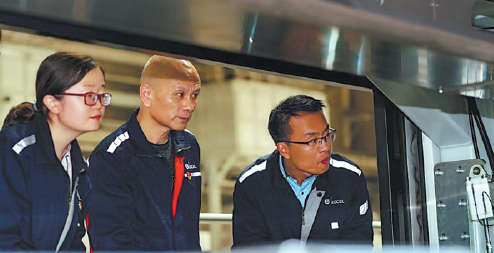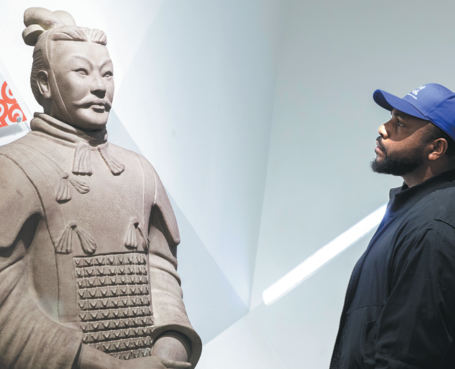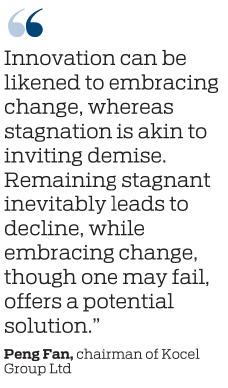Promising outlook for private enterprises





Government policies, economic conditions, market opportunities, technological advancements all point to significant potential for growth of nonpublic sector
In 1983, Peng Fan, a 20-year-old graduate from Sichuan province, found himself at the doorstep of a gritty machine tool foundry in Yinchuan, nestled among the windswept landscapes of the Ningxia Hui autonomous region.
As Peng looked at the yellow sand and worn-out factory, little did he realize that this very spot would grow into a global powerhouse in 3D printing.
At the time, Yinchuan was considered less developed, but the stark reality he was seeing far exceeded his imagination: workers with faces smeared black, dust filling the workshops, outdated production equipment and products limited to making manhole covers.
Yet, it somehow fueled Peng's determination to not only persevere, but also make a difference.
Going from being a technician to a workshop manager and now chairman, Peng said a spirit of hard work and a determination to innovate and break through barriers became the key factors in his later success in leading machine tool foundry's transformation into Kocel Group Ltd, and in introducing the company's 3D printers to the international market.
Currently, over 80 percent of Kocel's clients are Fortune Global 500 companies and industry leaders. Among its 20 subsidiaries, 12 are national-level high-tech enterprises, while three have been recognized as "little giant" firms by the Ministry of Industry and Information Technology.
Little giant firms are top performers of small and medium-sized enterprises among specialized, high-end and innovation-driven manufacturing sectors.
Kocel also boasts more than 10 innovation platforms, both at national and provincial levels.
At a private enterprise symposium held in Beijing on Feb 17, Peng was the only entrepreneur representative from Ningxia to participate in the event attended by China's top leadership.
Peng highlighted how conversations during the event notably enhanced the confidence of private enterprises.
"The current environment, government policies, economic conditions, market opportunities, and technological advancements all contribute to a significant potential for growth. In an era where technology drives the progression of the fourth industrial revolution, the outlook for private enterprises is both expansive and promising," he said.
On international stage
Peng's pursuit of technological innovation dates back to the late 1980s when he accompanied then factory director Sun Wenjing on a sales trip to Japan to promote castings, only to be ridiculed for their product quality.
To meet the needs of its Japanese clients, staff members — from factory leaders to chief engineers and workshop managers — focused on technical improvements.
After two months of preparations, the samples were approved by the Japanese clients.
Subsequently, the foundry gradually established joint ventures with Japanese companies.
After gaining a foothold in the Japanese market, they set their sights on the European and US markets, targeting an order from US-based General Electric Co for power machinery castings.
At the time, high-end castings in China were reliant on imports, and GE's requirements for gas turbine casings were stringent, requiring precision testing through X-rays, ultrasonic waves, and standards far exceeding domestic levels.
After prolonged efforts of systematic process improvements and alignment with standards, as well as nearly 100 million yuan ($13.8 million) in equipment upgrades, Kocel Group Ltd successfully received orders from General Electric, becoming a major supplier in the Asia-Pacific region.
This breakthrough quickly triggered a chain reaction, with international companies such as Siemens in Germany signing cooperation agreements.
"In the past, manufacturing companies focused more on production and manufacturing, investing more people and resources in this area, while marketing as well as research and development were relatively weaker. With the development of digitization and intelligence, manufacturing has become less labor-intensive, with investments in marketing as well as research and development growing larger," Peng said.
Despite the current challenges faced by China's manufacturing sector in expanding globally, including geopolitical tensions and trade conflicts, Peng emphasized that leveraging technology-driven products and implementing the "close enough to clients" strategy — establishing branches or factories near clients overseas — are crucial factors for achieving success.
Zhou Mi, a senior researcher at the Chinese Academy of International Trade and Economic Cooperation, shared a similar view.
Zhou noted that industries like machinery are now facing more complex overseas environments and heightened investment scrutiny from host countries.
He emphasized the importance of seizing opportunities in competitive markets such as the Middle East and emerging economies.
Furthermore, Zhou stressed the need for companies to embrace technological and environmentally friendly practices by developing green technologies, adopting new energy solutions, supporting eco-friendly initiatives, and actively engaging in sustainable development efforts.
Manufacturing innovation
In 2012, Peng first encountered 3D printing technology abroad and realized that this would be a revolutionary breakthrough for the casting industry. However, the integration of traditional casting with 3D printing posed exceptionally high difficulties, and internal opposition was relentless.
"There were voices that (said) once we fail, we'll lose everything."
Peng defied the odds, investing 2 billion yuan in R&D and embarking on a multiyear challenge.
During the R&D process, there were several years of investment exceeding profits, he said.
"We invested over 2 billion yuan, unsure if it would succeed, and at one point, I was very anxious," he said.
Looking back now, Peng's decision at the time proved undoubtedly right.
In recent years, there have been heated discussions of the hyper competition in the manufacturing industry.
Many manufacturing companies have competed for market share through low-quality and homogeneous products, manifesting as price wars and surplus outdated capacity, without improving efficiency or technological progress, leading to an overall decline in industry profits.
On the reasons for the hyper-competition, Zhu Keli, executive director of the China Information Industry Association, highlighted several key factors: Constrained market capacity compels certain companies to engage in "price wars", a significant level of product homogenization, and a proliferation of low-level redundant construction of products.
At the policy level, a clear governance direction is evident.
The Central Economic Work Conference in December explicitly called for systemic regulation of cutthroat competition. Building upon this move, the 2025 Government Work Report underscored the removal of market barriers, advocating for strategic actions like eliminating entry and exit obstacles, enhancing factor allocation mechanisms, and establishing a unified national market.
In this context, intelligent manufacturing and differentiated competition offer a path forward for enterprises.
Peng cited Charles Handy's Second Curve theory to tell the transformation and upgrade story of his company.
The theory emphasizes that organizations must cultivate new growth drivers before their existing businesses reach maturity, and companies should consistently explore and pursue innovative revenue sources.
He said innovation and the adoption of new technologies are crucial for the traditional manufacturing sector to transition to value-added, future-oriented strategies.
Talking about the pressure that a company may face by investing heavily on innovation and not knowing if it works out, Peng said: "Innovation can be likened to embracing change, whereas stagnation is akin to inviting demise. Remaining stagnant inevitably leads to decline, while embracing change, though one may fail, offers a potential solution."
Peng and his team's striving for innovation has paid off.
Today, the company's 3D printing equipment has been among the top in global sales for five consecutive years, supplying a large group of the world's top 500 companies.
Its digital factory model has been promoted to areas such as the Yangtze River Delta region, with a fivefold increase in per capita efficiency and a 50 percent reduction in production cycles.
Peng said that at present, there are many AI models in industrial scenarios, such as those empowering production lines, factories, and management in manufacturing, which will trigger an intelligent transformation in production manufacturing.
"We have a plan for three to five years to develop AI models and scenarios and conduct small-scale verification and promotion in industrial scenarios. Our annual R&D investment accounts for more than 8 percent of sales revenue, investing about 100-200 million yuan," he said.
"Our goal is to achieve intelligence in high-end equipment manufacturing, 3D printing, and intelligent manufacturing services, further deepening AI empowerment and application. Later, we will conduct AI research development in different scenarios in the industrial field in the first three years, apply our technology in production, and promote the experience to other players in the industry," he added.
Peng said that the current environment, policies, economic situation, market space, and technological area have brought broad development prospects for enterprises.
"The government supports the development of the private economy, and the rest is to roll up our sleeves and work. In terms of innovation capability, adapting to the market, and development, private enterprises have unique advantages. In an era of technology as the driving force for the fourth industrial revolution transformation and development, private enterprises have broad prospects and great potential," he said.
The remarks echoed the primary objectives outlined in the Government Work Report, emphasizing the crucial need for the effective implementation of policies and measures to bolster the growth of the private sector, all the while safeguarding the lawful rights and interests of private enterprises and entrepreneurs.
Furthermore, the report advocated for capable private companies to cultivate a robust modern corporate framework infused with distinct Chinese characteristics, positioning this as a focal point in the government's agenda for 2025.
According to data released by the State Administration for Market Regulation, as of the end of January, the total number of private enterprises in China had surged to 56.7 million, marking a 4.2-fold increase compared to the number recorded in 2012.
Contact the writers at liuyukun@chinadaily.com.cn




















